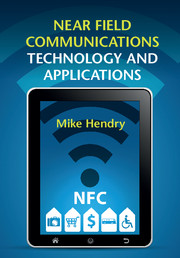Book contents
- Frontmatter
- Contents
- Part I Introduction
- Part II Technology
- 3 Standards
- 4 Modes of operation
- 5 RF requirements and components
- 6 The Secure Element
- 7 Tags and terminals
- 8 NFC apps
- 9 Infrastructure requirements
- 10 Security
- 11 Interoperability
- Part III Applications
- Part IV Implementation
- Appendix A Glossary
- Appendix B Standards
- Index
- References
4 - Modes of operation
from Part II - Technology
Published online by Cambridge University Press: 05 December 2014
- Frontmatter
- Contents
- Part I Introduction
- Part II Technology
- 3 Standards
- 4 Modes of operation
- 5 RF requirements and components
- 6 The Secure Element
- 7 Tags and terminals
- 8 NFC apps
- 9 Infrastructure requirements
- 10 Security
- 11 Interoperability
- Part III Applications
- Part IV Implementation
- Appendix A Glossary
- Appendix B Standards
- Index
- References
Summary
Currently there are three main types of NFC device: NFC-enabled phones, readers (such as point of sale terminals or public transport gates) and tags. NFC transactions can also be initiated by using devices like contactless cards, because of their compatibility with NFC, and we can also envisage a range of generic “smart objects,” which meet the NFC specs or form part of an NFC interaction.
As the previous chapter showed, NFC is a toolkit not a single specification: there are many “use cases” (interactions between a human actor and the system) and ways in which NFC can be used. All of these have in common the “NFC tap”: the initiation of a transaction or data exchange by tapping or bringing two devices together. But this can happen in different ways according to the type of device, the transaction to be performed and the application or geographic region, as follows, for example.
To read an NFC tag using a phone, the phone sends out a signal, which is received by the tag; the tag (which has no independent power) receives the signal and returns its data.
To use the same phone to pay in a shop, the phone must wait for the point of sale terminal to poll it before replying and starting an exchange of data. Since payment cards use ISO 14443 Type B, the phone must use these protocols.
In a public transport system in Japan or Hong Kong, cards are Type F, so the phone must switch to this set of protocols. In the USA, Type A is most widely used.
In a warehousing system, items may be tagged by using Vicinity Card (ISO 15693) standards [1] and so an NFC phone or reader seeking to read these tags must use the VCD mode and modulation techniques.
The NFC standards have the flexibility and options to support all of these, but not every device supports every option and different modes may require different infrastructure or connectivity.
- Type
- Chapter
- Information
- Near Field Communications Technology and Applications , pp. 32 - 46Publisher: Cambridge University PressPrint publication year: 2014



